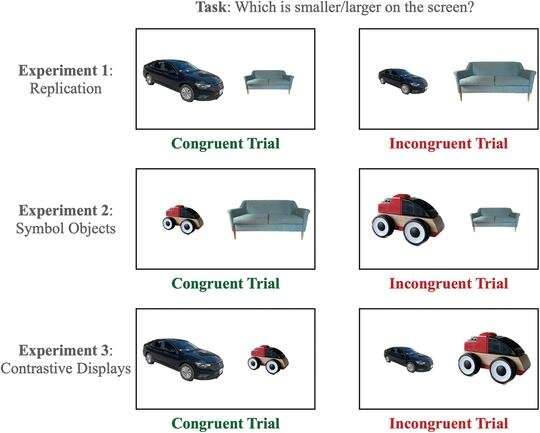Researchers challenge conventional view of visual perception. Is it really a horse or the photo of a horse?

If you were shown a photo of a horse and asked what it is, you would likely say, "a horse." But, of course, it isn't a horse, and you would be aware of this: you cannot feed or ride the photo in your hand. Yet, when studying visual perception, researchers often take it for granted that people see a horse when they look at a photo of a horse. This may be a mistake.
In a recent paper entitled "Images of Objects are Interpreted as Symbols: A Case Study of Automatic Size Measurement" published in the Journal of Experimental Psychology: General, researchers from Central European University's Department of Cognitive Science challenge the conventional view according to which a picture of a horse is recognized as a horse simply because it resembles one.
Instead, Gabor Brody, Barbu Revencu, and Gergely Csibra argue that people interpret images of objects as symbols—visual objects through which people communicate with each other. In this alternative view, a picture of a horse represents a horse, because a horse-looking object is a straightforward way to communicate about horses.
To find out whether photos are just recognized as objects or are interpreted as symbols, the authors investigated how people interpret photos of toys—small objects that often represent much larger objects. For instance, a toy zebra is a small object and a conventional symbol of a large animal. This dual nature of toys makes them very good candidates for teasing the two views apart. On the one hand, if people simply recognize photos, they should see a small object in the toy zebra photo. On the other, if they interpret photos symbolically, they would interpret the toy zebra photo as (a symbol for) a zebra.
To get at people's spontaneous interpretation of images, the authors built on previous studies in which people were shown two photos of different sizes and asked to select which image is larger. People found the task harder when the sizes of items in the photos didn't match their real-world knowledge. For instance, when shown a small photo of a zebra next to a large photo of a watermelon, people were slow to select the larger watermelon image.
They could not ignore their knowledge that zebras are larger than watermelons in the real world. When confronted with toys, however, participants were slow when they saw a small photo of a toy zebra next to a large photo of a watermelon even though this pairing preserves the real-world size difference of the two objects: watermelons are larger than toy zebras.
"This indicates that people did not merely recognize objects in images," says researcher Gabor Brody. "If they did, participants would have recognized the toy zebra for the small object it actually is."
Moreover, these findings did not arise because people mistook the toys for the real entities the toys represented. When people had to choose between photos of a zebra and a toy zebra, they interpreted the toys as small objects. "This flexibility is remarkable: an image of a toy zebra is interpreted as a zebra when next to an image of a watermelon, but as a toy when next to an image of a zebra," reflects Barbu Revencu.
"Taken together, these experiments show not only that people interpret object photos as symbols, but that they do so in a flexible manner, taking into account the entire display when figuring out what a photographed object is meant to depict," concludes Professor Csibra.
More information: Brody, G., Revencu, B., & Csibra, G. (2022). Images of objects are interpreted as symbols: A case study of automatic size measurement, Journal of Experimental Psychology: General (2022). Advance online publication. doi.org/10.1037/xge0001318



















